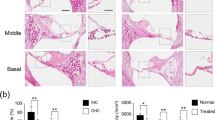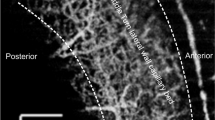Summary
Changes in cochlear microcirculation and oxygenation and auditory function were examined in anesthetized guinea pigs during prolonged hypoxic ventilation (8% oxygen in nitrogen) for 1 h. Cochlear blood flow and perilymphatic oxygen partial pressure were measured using laser Doppler flowmetry and oxygen-sensitive microelectrodes. Auditory function was examined by recording cochlear microphonics, compound action potentials and auditory evoked brainstem response. Blood pressure and heart rate were monitored. During systemic hypoxia, the perilymphatic PO2 dropped on average to about 70% of the initial value. Cochlear and brainstem potentials showed a mean reduction to 75–82%. Different effects of hypoxia on cochlear blood flow were observed and included decreases as well as increases. Mean arterial blood pressure declined significantly during hypoxia, while the heart rate remained constant. The changed variables returned to normal during reventilation with room air. The findings are discussed with regard to their significance as an animal model for the study of hypoxia-induced cochlear pathophysiology.
Similar content being viewed by others
References
Bohne B-D, Rolle W, Strobl R, Ulrich W-D (1973) Mantel-Thermoelemente zur Temperaturmessung in Medizin und Biologic. Medizintechnik 13:13–16
Bornschein H, Krejci (1949) Das Verhalten der Cochlearpotentiale bei Sauerstoffmangel. Monatsschr Ohrenheilkd 83:190–196
Fernandez C (1955) The effect of oxygen lack on cochlear potentials. Ann Otol Rhinol Laryngol 64:1193–1203
Fernandez C, Alzate R (1959) Modifications of cochlear responses by oxygen deprivation. Arch Otolaryngol 69:82–94
Gisselsson L (1954) The effect of oxygen lack and decreased blood pressure on the microphonic response of the cochlea. Acta Otolaryngol (Stockh) 44:101–118
Haupt H, Scheibe F, Ludwig C, Petzold D (1991) Measurements of perilymphatic oxygen tension in guinea pigs exposed to loud sound. Eur Arch Otorhinolaryngol 248:413–416
Hildesheimer M, Muchnik C, Rubinstein M (1987) Cochlear action potentials threshold and systemic arterial pO2. Laryngoscope 97:204–207
Lawrence M, Nuttall AL (1972) Oxygen availability in tunnel of Corti measured by microelectrode. J Acoust Soc Am 52:566–573
Lawrence M, Nuttall AL, Burgio PA (1975) Cochlear potentials and oxygen associated with hypoxia. Ann Otol Rhinol Laryngol 84:499–512
Lawrence M, Nuttall AL, Burgio PA (1977) Oxygen reserve and autoregulation in the cochlea. Acta Otolaryngol (Stockh) 83:146–152
Maass B, Baumgärtl H, Lübbers DW (1976) Lokale pO2-Messungen mit Nadelelektroden zum Studium der Sauerstoffversorgung und Mikrozirkulation des Innenohres. Arch Otorhinolaryngol 214:109–124
Mayahara T, Perlman HB (1972) Cochlear microcirculation and oxygen transport. Laryngoscope 82:578–597
Morgenstern C, Kessler M (1978) Oxygen consumption and oxygen distribution in the inner ear. Arch Otorhinolaryngol 220:159–162
Pierson MG, Møller AR (1982) Corresponding effects of bypoxia on the cochlear microphonic and the compound action potential. Hear Res 6:83–101
Prazma J (1982) Perilymphatic and endolymphatic pO2. Variations during anoxia, hyperoxia, and hypercapnia. Arch Otolaryngol 108:539–543
Sasa H, Nagahara K, Yamashita T, Kumazawa T (1989) Gas permeability of round window membrane. ORL 51:88–93
Sato K (1988) Pharmacokinetics of coenzyme Q10 in recovery of acute sensorineural hearing loss due to hypoxia. Acta Otolaryngol (Stockh) [Suppl] 458:95–102
Scheibe F, Ludwig C, Haupt H, Flemming B (1989) Physiologische Parameter des Meerschweinchens unter Langzeitnarkose mit kontrollierter Beatmung. Z Versuchstierkd 32:25–31
Scheibe F, Haupt H, Nuttall AL, Ludwig C (1990) Laser Doppler measurements of cochlear blood flow during loud sound presentation. Eur Arch Otorhinolaryngol 247:84–86
Scheibe F, Haupt H, Ludwig C (1992) Intensity-dependent changes in oxygenation of cochlear perilymph during acoustic exposure. Hear Res 63:19–25
Sohmer H, Freeman S (1991) Hypoxia induced hearing loss in animal models of the fetus in-utero. Hear Res 55:92–97
Tonndorf J, Hyde RW, Brogan FA (1955) Combined effect of sound and oxygen deprivation upon cochlear microphonicsin guinea pigs. Ann Otol Rhinol Laryngol 64:392–405
Wagner H, Berndt H, Gerhardt H-J (1974) Zur Erzeugung kalibrierter Schallpegel am Trommelfell des Meerschweinchens. Arch Otorhinolaryngol 206:283–292
Author information
Authors and Affiliations
Rights and permissions
About this article
Cite this article
Haupt, H., Scheibe, F. & Ludwig, C. Changes in cochlear oxygenation, microcirculation and auditory function during prolonged general hypoxia. Eur Arch Otorhinolaryngol 250, 396–400 (1993). https://doi.org/10.1007/BF00180384
Received:
Accepted:
Issue Date:
DOI: https://doi.org/10.1007/BF00180384




